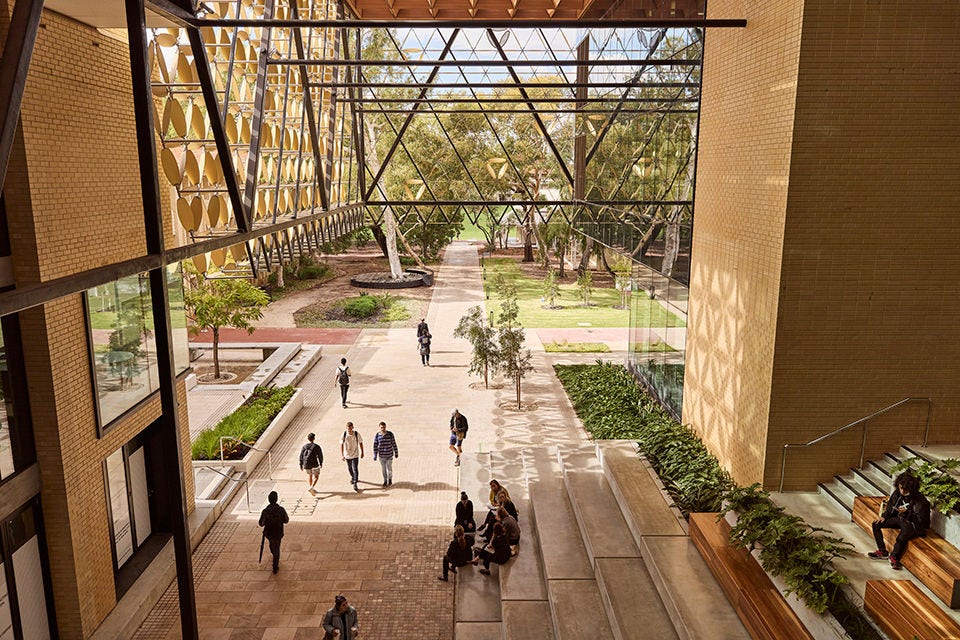Why Australia?
Courses designed to meet industry requirements
Education providers in Australia work closely with those in the architecture, construction and planning industries to create and update their courses and teaching methods.
A qualification that takes you places
Australia’s top architecture, construction and planning accreditation groups have agreements with others throughout the world – including in Canada, New Zealand, the United States and countries throughout Asia.
World class courses
Australian education providers and courses are consistently ranked among the best in the world. Every provider in Australia needs to complete an accreditation process to deliver the highest standard of teaching and learning.
Study options
The field of architecture, construction and planning is about creating, maintaining and improving our built and natural environments.
The three areas are different, but closely related. People in architecture, construction and planning roles often all need to work together to create a successful project. They make sure built structures meet our needs. They give us shelter, places where we can learn and work, spaces where we can have fun, and more. Importantly, these professionals also make spaces and structures safe for us to use.
Architecture is both an art and a science. It deals with planning, designing and constructing buildings and other structures. People in this field come up with design solutions to a variety of economic, social and environmental challenges.
Construction, or building, involves the physical construction of buildings and related infrastructure, like roads, power and water supplies. It can also involve demolition, renovation, maintenance and repair work.
Planning looks at buildings and infrastructure in their wider contexts. It helps to make sure what we build serves its purpose, and considers the impacts it might have on communities and the environment.
This field of study is great if you are a creative thinker or like solving problems, or if you enjoy using your hands to design and build things.
Popular courses include:
- Bachelor of Architectural Design
- Bachelor of urban and regional planning
- Diploma of Building and Construction (Building)
Vocational education and training (VET) or university?
Many people employed in construction complete certificates and diplomas in vocational education and training (VET), which can be completed at public TAFE institutions or private VET providers. These qualifications take between six months and two years to complete, depending on your course and level of study.
To become a fully registered architect, you will need to complete a Bachelor degree and a Master degree at university – a total of five years of study – and complete another two years of professional practice after your studies.
Fast facts
Quality education
8 Australian universities are ranked in the world’s top 100 for architecture and built environment studies. (Source: QS World University Rankings by Subject 2024).
Industry demand
Demand for construction managers in Australia is expected to grow by at least 10% (11,400 people) from 2021 to 2026.
Salary expectations
People in Australia earn A$1,305 each week on average in the construction industry.
Career options
Architecture, construction and planning professionals work across many different parts of the built environment. They plan, create, maintain and improve the spaces in which we live and work.
Some of the broad areas you might be employed in are:
- architecture
- building conservation
- construction (residential and non-residential)
- planning and development
- property and estate management.
Across these, there are many career paths to choose from. Popular career choices include:
- interior designer
- urban planner / town planner
- architect
- construction manager
- real estate agent
- building surveyor
- project manager
- plumber
- electrician
- builder
- occupational health and safety (OH&S) manager.
Depending on which study path and career you choose, your future might involve projects as varied as:
- making older buildings more environmentally sustainable
- designing or building large, complex structures that need to suit a particular purpose, like schools
- installing and fixing electricity, air conditioning or plumbing
- creating accessible spaces for people with disability
- planning the layout or transport routes in a new suburb
- making sure building work is done in a way that meets legal requirements.
While the career options are diverse, what they all have in common is that they work together to solve problems – whether it’s making sure a home has running water, ensuring people have outdoor spaces to enjoy in a new suburb, or designing a hospital with doorways wide enough for beds to fit through.
About the industries
Architecture, construction and planning services are in high demand in Australia. The industries have always been strong, but are expected to grow strongly in future.
In 2022, there were around 1.1 million people employed in the construction industry in Australia. Between 2021 and 2026, it is expected to grow by 5.8% – an extra 66,400 jobs.
Employment in architecture and landscape architecture is also expected to grow strongly. From 2021 to 2026, the number of jobs is expected to grow by 16.8% – from 26,400 to 30,800 jobs.
Urban and regional planners can also expect to be in demand. Between 2021 and 2026, the number of jobs is likely to grow by 18.6% – from 13,600 to 16,200 jobs.
Find out more about jobs and salaries.
Jobs in demand
The Australian Industry and Skills Committee has identified the most in-demand jobs as:
- Architectural, Building and Surveying Technicians
- Contract, Program and Project Administrators
- Electricians
- Carpenters and Joiners




